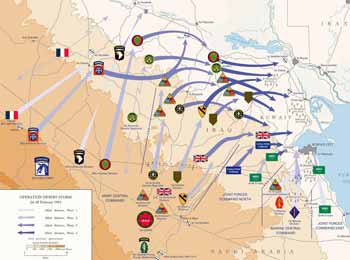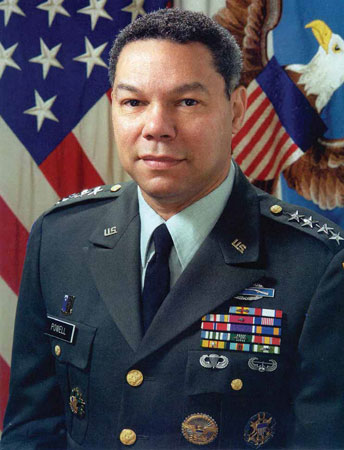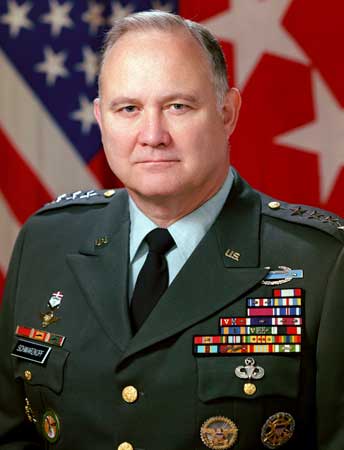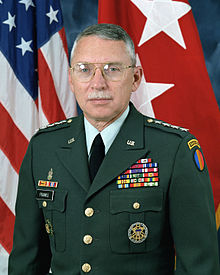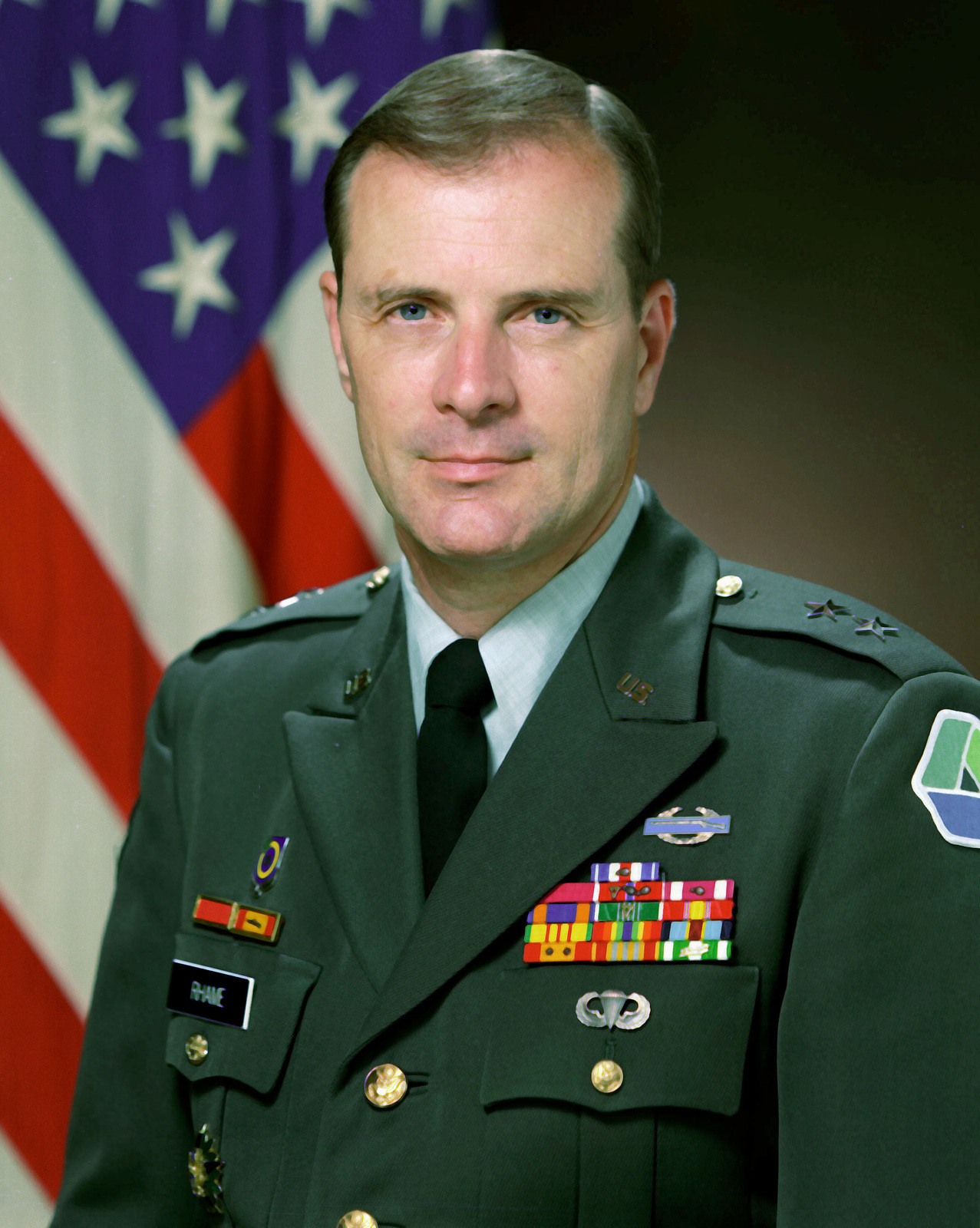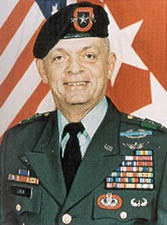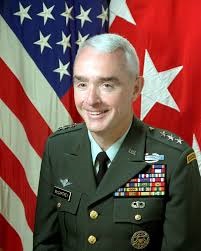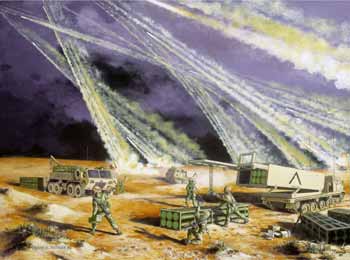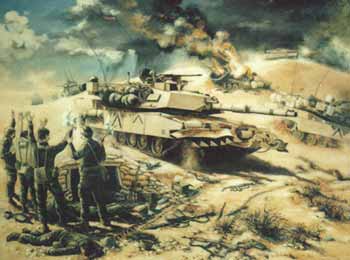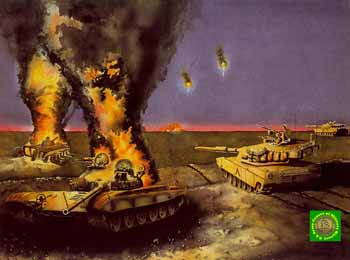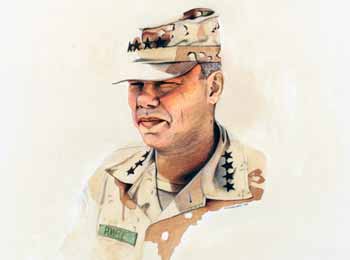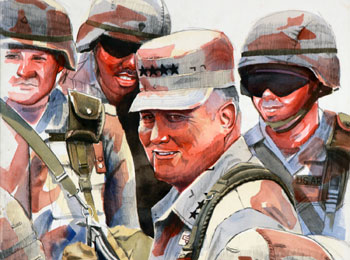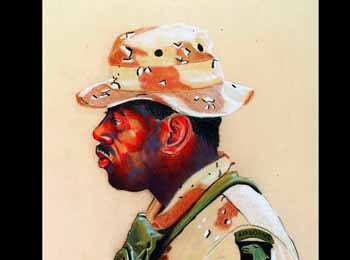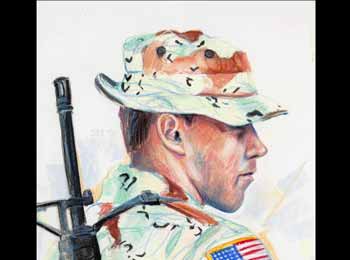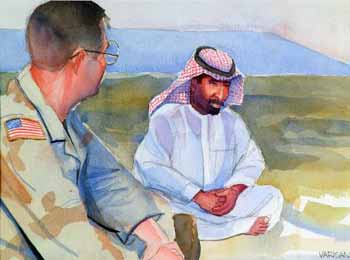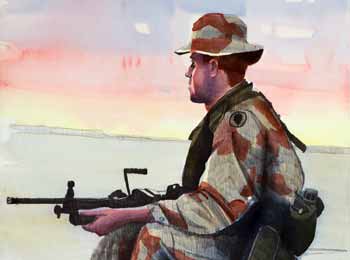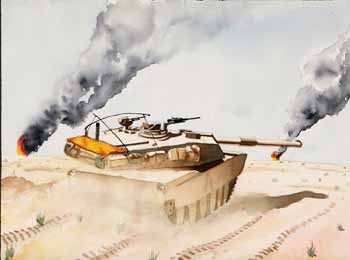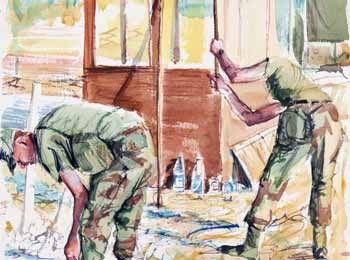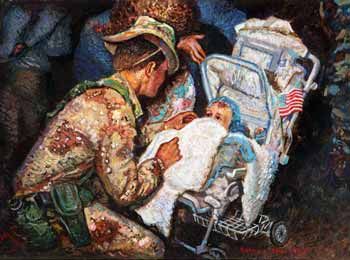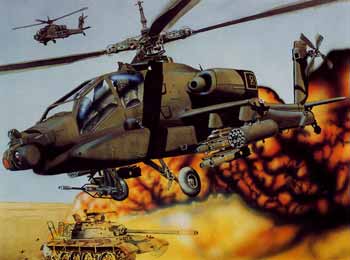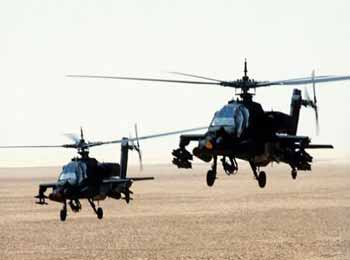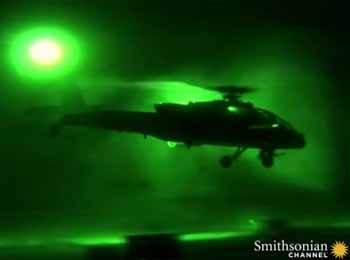DESERT STORM Overview
AIR CAMPAIGN
Early on 17 January 1991, Operation desert shield came to an end when the air campaign of Operation desert storm began. Task Force normandy, consisting of nine AH-64 Apache helicopters from the U.S. Army's 101st Aviation Regiment, 101st ABN DVN (Air Assault), accompanied by four Air Force MH-53 Pave Low special operations helicopters, flying fast and low, opened fire at 0236 - Baghdad time - on 17 January.
After their 27 Hellfire missiles destroyed Iraqi radar sites, the Apaches followed with 100 Hydra-70 rockets that knocked out the associated anti-aircraft guns. The attack created a twenty-mile gap in the enemy's air defense network opening a corridor through which U.S. Air Force F-15E Strike Eagle fighters, supported by EF-111 Ravens, raced into Iraqi air-space virtually unopposed followed by hundreds of U.S. Air Force, Navy, Marine Corps and Coalition fixed-wing aircraft and cruise missiles.
Operating almost with impunity, U.S. and allied air forces pummeled Iraqi positions and supply lines. Massive B–52 strikes, and almost equally devastating psychological warfare leaflet drops, did much to sap the Iraqis’ will to fight.
GROUND CAMPAIGN
Finally, on 24 February, the ground war began. Hours before the start of the offensive, special reconnaissance teams from the 5th and 3d Special Forces Groups (Airborne), 1st Special Forces, flying out of King Khalid Military City on specially configured helicopters, were sent deep behind Iraqi lines to gather intelligence. Kicking off the main attack in bad weather, the XVIII Airborne Corps quickly made an end run around the open right flank of the Iraqi Army. Simultaneously, U.S. and allied forces in the east attacked directly north toward Kuwait City. The Tiger Brigade (1st Brigade, 2d Armored Division), supporting Marine Corps units, pushed directly north from Saudi Arabia through blazing Kuwaiti oil fields set on fire by retreating Iraqis. By midafternoon on the first day of battle, elements of the 101st and 82d Airborne Divisions were deep into Iraq, in one case just twenty-four miles south of the Euphrates River.
Due to the speed of the allied advance, the VII Corps began its attack ahead of schedule early in the afternoon on the twenty-fourth. Penetrating the minefields to their front, U.S. soldiers from the 1st Infantry Division overran Iraqi positions within a few hours. The Iraqi troops—tired, hungry, and physically and psychologically battered—began surrendering in droves. The next day the 1st Armored Division quickly crushed the Iraqi 26th Infantry Division as VII Corps pivoted to the east.
The 24th Infantry Division’s heavy armor moved rapidly northward, meeting sporadic resistance from demoralized Iraqi troops. Linking up with the 101st battle positions, the 24th Division moved the 200 miles north to the Euphrates River Valley by noon on the twenty-sixth, blocking a major Iraqi supply route and possible avenue of retreat.
In one of the most decisive actions of the war, the VII Corps, moving directly east with three heavy divisions abreast, attacked the elite Iraqi Republican Guard units. Late in the afternoon on the twenty-sixth, the VII Corps hit elements of the Tawakalna Division in the battle of 73 Easting. In quick succession, the 2d ACR, 1st and 3d Armored Divisions, and the 1st Infantry Division smashed through the Tawakalna Division. Overwhelming the enemy with accurate tank fire and assisted by deadly Apache helicopter gunships, the VII Corps hit the Medina Division in the early afternoon of the twenty-seventh. At the Battle of Medina Ridge, the 1st Armored Division discovered an attempted Iraqi ambush and destroyed over 300 enemy tanks.
The battles of desert storm soon wound down against crumbling resistance. With the VII Corps poised to crush the remainder of the Republican Guard units, only the declaration of a cease-fire saved the Iraqis. When, two days after the cease-fire, elements of the Republican Guard’s Hammurabi Division engaged the 1st Brigade, 24th Infantry Division, just north of Highway 8, the Iraqis lost over 185 armored vehicles and 400 trucks within a few hours.
In 100 hours, U.S. and allied ground forces in Iraq and Kuwait decisively defeated a battle-hardened and dangerous enemy. During air and ground operations, U.S. and allied forces destroyed over 3,000 tanks, 1,400 armored personnel carriers, and 2,200 artillery pieces along with countless other vehicles. This was achieved at a cost to the United States of 96 soldiers killed in action, 2 died of wounds, and 105 non-hostile deaths.
AFTERMATH
With Kuwait liberated, U.S. forces immediately turned to humanitarian missions. They sorted out refugees, assisted the Kuwaitis in reoccupying their city, and helped them begin the long process of rebuilding. U.S. Army Civil Affairs and Corps of Engineer units set up food, water, and fuel distribution points and medical clinics. The American instrument of war became a force for peace. The long struggle of reconstruction was just beginning as most of the victorious U.S. Army combat units headed home.
OPERATION desert storm: MODERNIZATION VALIDATION
Successful execution of the attack was the result of months of training with our coalition allies and validated the soundness of the Air-Land Battle doctrine. Air-Land Battle was developed after the Vietnam War for conventional warfare and oriented on the European theater but tested during Operation desert storm.
The Army’s performance also justified the investment in new military hardware in the 1980s, including the “big five”: Abrams tanks, Apache attack helicopters, Bradley fighting vehicles, Black Hawk utility helicopters, and the Patriot missile system.
The Army’s Total Force concept of using Reserve forces helped maintain an effective force on the battlefield and ensure security around the world. Approximately 147,00 Reserve Component Soldiers were called to active duty, of whom 73,431 deployed to Southwest Asia. Reserve Component units also reconstituted the Army’s strategic contingency corps to deter other potential adversaries from taking advantage of U.S. focus in the Persian Gulf.
Army Training and Doctrine Command (TRADOC) led the effort to learn from desert storm and is revolutionizing the Army for the next fight with Multi-Domain Operations doctrine.
Operation desert storm ushered in what is commonly referred to as “The First Space War.” It was the first major military operation to make extensive use of space-enabled capabilities.
- The Global Positioning System helped U.S. and coalition forces win the ground war after only four days of ground combat. It was the first major land campaign involving the widespread use of GPS for land navigation and targeting.
- Satellite communications (SATCOM) provided 80 percent of theater communications, both inter and intra. Intra-theater SATCOM was especially important because of the vast operational area in which there did not already exist a communications infrastructure.
- During desert storm, Friendly Force Tracking provided ground commanders with never-before seen situational awareness and command and control capabilities for Army forces employed across the battlefield.


